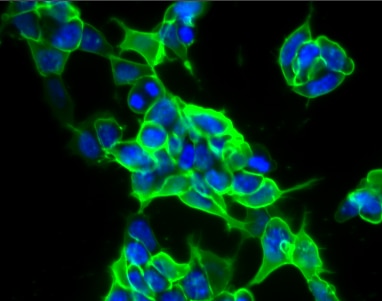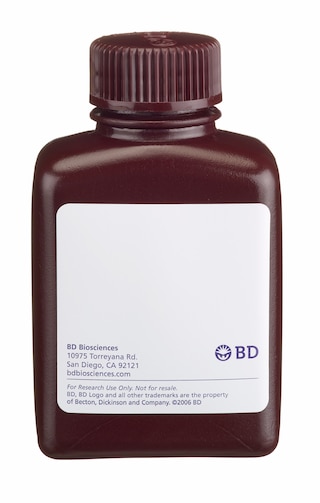-
抗体試薬
- フローサイトメトリー用試薬
-
ウェスタンブロッティング抗体試薬
- イムノアッセイ試薬
-
シングルセル試薬
- BD® AbSeq Assay | シングルセル試薬
- BD Rhapsody™ Accessory Kits | シングルセル試薬
- BD® Single-Cell Multiplexing Kit | シングルセル試薬
- BD Rhapsody™ Targeted mRNA Kits | シングルセル試薬
- BD Rhapsody™ Whole Transcriptome Analysis (WTA) Amplification Kit | シングルセル試薬
- BD Rhapsody™ TCR/BCR Profiling Assays (VDJ Assays) | シングルセル試薬
- BD® OMICS-Guard Sample Preservation Buffer
- BD Rhapsody™ ATAC-Seq Assays
-
細胞機能評価のための試薬
-
顕微鏡・イメージング用試薬
-
細胞調製・分離試薬
-
- BD® AbSeq Assay | シングルセル試薬
- BD Rhapsody™ Accessory Kits | シングルセル試薬
- BD® Single-Cell Multiplexing Kit | シングルセル試薬
- BD Rhapsody™ Targeted mRNA Kits | シングルセル試薬
- BD Rhapsody™ Whole Transcriptome Analysis (WTA) Amplification Kit | シングルセル試薬
- BD Rhapsody™ TCR/BCR Profiling Assays (VDJ Assays) | シングルセル試薬
- BD® OMICS-Guard Sample Preservation Buffer
- BD Rhapsody™ ATAC-Seq Assays
- Japan (Japanese)
-
Change country/language
Old Browser
Looks like you're visiting us from {countryName}.
Would you like to stay on the current country site or be switched to your country?


.png)

Immunofluorescent staining of mouse ES cell line. ES-E14TG2a cells (ATCC CRL-1821) were cultured, fixed, and stained with Alexa Fluor® 488 Mouse anti-SSEA-1 (pseudo-colored green) according to the Recommended Assay Procedure. Counter-staining was with Hoechst 33342 (pseudo-colored blue). The images were captured on a BD Pathway™ 435 Cell Analyzer using a 20X objective and merged using BD Attovision™ software. This antibody also stained F9 cells (ATCC CRL-1720; mouse embryonal carcinoma). Methanol and Triton X100 permeabilization agents are not recommended for use with this antibody.
.png)

BD Pharmingen™ Alexa Fluor® 488 Mouse anti-SSEA-1
.png)
Regulatory Statusの凡例
Any use of products other than the permitted use without the express written authorization of Becton, Dickinson and Company is strictly prohibited.
Preparation and Storage
推奨アッセイ手順
Recommended Assay Procedure:
1. Seed the cells in appropriate culture medium at an appropriate cell density in a BD Falcon™ 96-well Imaging Plate (Cat. No. 353219), and culture overnight to 48 hours.
2. Remove the culture medium from the wells, wash the wells twice with 100 μl of 1× PBS, and fix the cells by adding 100 µl of fresh 3.7% Formaldehyde in PBS or BD Cytofix™ fixation buffer (Cat. No. 554655) to each well and incubating for 10 minutes at room temperature (RT).
3. Remove the fixative from the wells, and wash the wells twice with 100 μl of 1× PBS.
4. Dilute the antibody 1:10 in 1× PBS, and stain the cells by adding 50 µl of the diluted antibody conjugate to each well and incubating for 1 hour at RT.
5. Remove the diluted antibody, and wash the wells twice with 100 μl of 1× PBS.
6. Remove the PBS, and counter-stain the nuclei by adding 100 μl of a 2 μg/ml solution of Hoechst 33342 (eg, Sigma-Aldrich Cat. No. B2261) in 1× PBS to each well at least 15 minutes before imaging.
7. View and analyze the cells on an appropriate imaging instrument. Recommended filters for the BD Pathway™ cell analyzers are:
Instrument Excitation Emission Dichroic
BD Pathway 855 488/10 515 LP Fura/FITC
BD Pathway 435 482/35 536/40 FF506
Product Notices
- Please refer to www.bdbiosciences.com/us/s/resources for technical protocols.
- This reagent has been pre-diluted for use at the recommended Volume per Test when following the Recommended Assay Procedure. A Test is typically ~10,000 cells cultured in a well of a 96-well imaging plate.
- The Alexa Fluor®, Pacific Blue™, and Cascade Blue® dye antibody conjugates in this product are sold under license from Molecular Probes, Inc. for research use only, excluding use in combination with microarrays, or as analyte specific reagents. The Alexa Fluor® dyes (except for Alexa Fluor® 430), Pacific Blue™ dye, and Cascade Blue® dye are covered by pending and issued patents.
- Source of all serum proteins is from USDA inspected abattoirs located in the United States.
- Caution: Sodium azide yields highly toxic hydrazoic acid under acidic conditions. Dilute azide compounds in running water before discarding to avoid accumulation of potentially explosive deposits in plumbing.
- Alexa Fluor® is a registered trademark of Molecular Probes, Inc., Eugene, OR.
The MC480 monoclonal antibody reacts with Stage-Specific Embryonic Antigen-1 (SSEA-1), which is a terminal carbohydrate epitope (3-fucosyl-N-acetyllactosamine or 3-FAL) on glycoproteins and lactose-series glycolipids. SSEA-1 is related to Lewis blood group antigens and is found in a variety of embryonic as well as adult tissues and cancers. As its name implies, the expression of SSEA-1 is stage-specific and can be used to characterize embryonic cells and monitor their differentiation. However, its expression pattern differs between human and mice. In the human, SSEA-1 is not found on embryonic stem (ES) cells, embryonic inner cell mass (ICM), or teratocarcinoma (embryonal carcinoma or EC) cells. As human EC and ES cells undergo differentiation, SSEA-1 expression is upregulated. In the adult, the same epitope is expressed as CD15 on granulocytes and monocytes, but not lymphocytes or dendritic cells. In the mouse, SSEA-1 is found on EC, ES, primordial germ cells, 8-cell to blastocyst embryos, ICM, and subpopulations of cells in the adult central nervous system, including stem cells. In contrast to human SSEA-1 expression, it is reduced when mouse EC and ES cells undergo differentiation.
Development References (7)
-
Capela A, Temple S. LeX/ssea-1 is expressed by adult mouse CNS stem cells, identifying them as nonependymal. Neuron. 2002; 35:865-875. (Biology).
-
Childs RA, Pennington J, Uemura K, et al. High-molecular-weight glycoproteins are the major carriers of the carbohydrate differentiation antigens I, i and SSEA-1 of mouse teratocarcinoma cells. Biochem J. 1983; 215:491-503. (Clone-specific: Immunofluorescence, Western blot).
-
Draper JS, Pigott C, Thomson JA, Andrews PW. Surface antigens of human embryonic stem cells: changes upon differentiation in culture. J Anat. 2002; 200:249-258. (Clone-specific: Flow cytometry). View Reference
-
Henderson JK, Draper JS, Baillie HS, et al. Preimplantation human embryos and embryonic stem cells show comparable expression of stage-specific embryonic antigens. Stem Cells. 2002; 20:329-337. (Clone-specific: Flow cytometry, Immunofluorescence). View Reference
-
Kannagi R, Nudelman E, Levery SB, Hakomori S. A series of human erythrocyte glycosphingolipids reacting to the monoclonal antibody directed to a developmentally regulated antigen, SSEA-1. J Biol Chem. 1982; 257(24):14865-14874. (Clone-specific).
-
Solter D, Knowles BB. Monoclonal antibody defining a stage-specific mouse embryonic antigen (SSEA-1). Proc Natl Acad Sci U S A. 1978; 75(11):5565-5569. (Immunogen: Cytotoxicity, Radioimmunoassay). View Reference
-
Thomson JA, Itskovitz-Eldor J, Shapiro SS, et al. Embryonic stem cell lines derived from human blastocysts. Science. 1998; 282:1145-1147. (Clone-specific: Immunocytochemistry (cytospins)). View Reference
Please refer to Support Documents for Quality Certificates
Global - Refer to manufacturer's instructions for use and related User Manuals and Technical data sheets before using this products as described
Comparisons, where applicable, are made against older BD Technology, manual methods or are general performance claims. Comparisons are not made against non-BD technologies, unless otherwise noted.
For Research Use Only. Not for use in diagnostic or therapeutic procedures.
Report a Site Issue
This form is intended to help us improve our website experience. For other support, please visit our Contact Us page.
